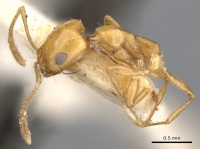Monomorium ilgii
| Monomorium ilgii | |
|---|---|

| |
| Scientific classification | |
| Kingdom: | Animalia |
| Phylum: | Arthropoda |
| Class: | Insecta |
| Order: | Hymenoptera |
| Family: | Formicidae |
| Subfamily: | Myrmicinae |
| Tribe: | Solenopsidini |
| Genus: | Monomorium |
| Species: | M. ilgii |
| Binomial name | |
| Monomorium ilgii Forel, 1894 | |
Known from the type series, nothing is known about the biology of Monomorium ilgii.
Identification
Bolton (1987) - A member of the M. tchelichofi complex in the M. salomonis species group. This distinctive species keys out with Monomorium excelsior and superficially the two appear to be closely related. For this reason I have included ilgii in the tchelichofi-complex, but I suspect that ilgii may have come to resemble excelsior convergently. Little more can be said at present as both are known only from their short type-series.
Keys including this Species
Distribution
Distribution based on Regional Taxon Lists
Afrotropical Region: Ethiopia (type locality).
Distribution based on AntMaps
Distribution based on AntWeb specimens
Check data from AntWeb
Countries Occupied
| Number of countries occupied by this species based on AntWiki Regional Taxon Lists. In general, fewer countries occupied indicates a narrower range, while more countries indicates a more widespread species. |

|
Estimated Abundance
| Relative abundance based on number of AntMaps records per species (this species within the purple bar). Fewer records (to the left) indicates a less abundant/encountered species while more records (to the right) indicates more abundant/encountered species. |

|
Biology
Castes
Nomenclature
The following information is derived from Barry Bolton's Online Catalogue of the Ants of the World.
- ilgii. Monomorium ilgii Forel, 1894b: 84 (w.) ETHIOPIA.
- Type-material: syntype workers (number not stated).
- Type-locality: Ethiopia (“Südabessinien”): (no further data) (A. Ilg).
- Type-depositories: BMNH, MHNG.
- Combination in M. (Xeromyrmex): Emery, 1922e: 177.
- Status as species: Emery, 1922e: 177; Wheeler, W.M. 1922a: 863; Ettershank, 1966: 89; Bolton, 1987: 346 (redescription); Bolton, 1995b: 262.
- Distribution: Ethiopia.
Unless otherwise noted the text for the remainder of this section is reported from the publication that includes the original description.
Description
Worker
Bolton (1987) - TL 2.7-3.1, HL 0.66-0.78, HW 0.51-0.60, CI 76-77, SL 0.52-0.62, SI 102-105, PW 0.34-0.38, AL 0.76-0.90 (3 measured).
Anterior margin of median portion of clypeus shallowly concave. Eyes relatively large and very conspicuous, the maximum diameter 0.33 x HW and with 9-11 ommatidia in the longest row. Sides of head evenly shallowly convex in full-face view, the convexity more marked in larger than in smaller workers. Occipital margin broadly but shallowly concave. Promesonotum in profile flat to shallowly convex dorsally, the metanotal groove only extremely feebly impressed. Propodeal dorsum flat to shallowly concave between the lateral marginations. Petiole node high and narrow in profile; both nodes narrow from front to back and conspicuously transverse in dorsal view, much broader than long. Cephalic dorsum with 4-5 pairs of hairs straddling the midline behind the frontal lobes, and the occipital margin with another pair situated close to the corners. Pronotal dorsum with 2-3 pairs of standing hairs, and larger workers also with a pair on the mesonotum. Propodeal dorsum without standing hairs. Petiole node with one pair and postpetiole with 3 pairs of elongate hairs. First gastral tergite with numerous standing hairs which are more or less evenly distributed over the entire sclerite. Head smooth, unsculptured except for very faint superficial reticular patterning. Pronotal dorsum similar to head but mesonotum with more conspicuous but still superficial reticulation. Propodeal dorsum with weakly reticulate-granulate sculpture. Sides of alitrunk behind the glossy pronotum weakly reticulate to reticulate-granulate. First gastral tergite unsculptured or at most with vestigial reticulate patterning basally. Colour uniform yellow.
Type Material
Bolton (1987) - Syntype workers, Ethiopia: 'Siidabessinien' (Ilg) (Musee d'Histoire Naturelle Genève; The Natural History Museum) [examined].
References
- Bolton, B. 1987. A review of the Solenopsis genus-group and revision of Afrotropical Monomorium Mayr (Hymenoptera: Formicidae). Bulletin of the British Museum (Natural History). Entomology. 54: 263-452. (page 346, see also)
- Emery, C. 1922c. Hymenoptera. Fam. Formicidae. Subfam. Myrmicinae. [part]. Genera Insectorum 174B: 95-206 (page 177, Combination in M. (Xeromyrmex))
- Forel, A. 1894b. Abessinische und andere afrikanische Ameisen, gesammelt von Herrn Ingenieur Alfred Ilg, von Herrn Dr. Liengme, von Herrn Pfarrer Missionar P. Berthoud, Herrn Dr. Arth. Müller etc. Mitt. Schweiz. Entomol. Ges. 9: 64-100. (page 84, worker described)
References based on Global Ant Biodiversity Informatics
- Ettershank G. 1966. A generic revision of the world Myrmicinae related to Solenopsis and Pheidologeton (Hymenoptera: Formicidae). Aust. J. Zool. 14: 73-171.
- Wheeler W. M. 1922. Ants of the American Museum Congo expedition. A contribution to the myrmecology of Africa. VIII. A synonymic list of the ants of the Ethiopian region. Bulletin of the American Museum of Natural History 45: 711-1004

